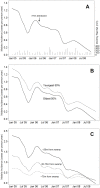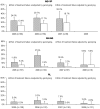Incidence of malaria and efficacy of combination antimalarial therapies over 4 years in an urban cohort of Ugandan children
- PMID: 20689585
- PMCID: PMC2912768
- DOI: 10.1371/journal.pone.0011759
Incidence of malaria and efficacy of combination antimalarial therapies over 4 years in an urban cohort of Ugandan children
Abstract
Background: Combination therapies are now recommended to treat uncomplicated malaria. We used a longitudinal design to assess the incidence of malaria and compare the efficacies of 3 combination regimens in Kampala, Uganda.
Methodology/principal findings: Children aged 1-10 years were enrolled from randomly selected households in 2004-05 and 2007, and were followed at least monthly through 2008. Insecticide-treated bednets (ITNs) were provided in 2006. Children were randomized upon their first episode, and then treated for all episodes of uncomplicated malaria with amodiaquine/sulfadoxine-pyrimethamine (AQ/SP), artesunate/amodiaquine (AS/AQ), or artemether/lumefantrine (AL). Risks of parasitological failure were determined for each episode of uncomplicated malaria and clinical parameters were followed. A total of 690 children experienced 1464 episodes of malaria. 96% of these episodes were uncomplicated malaria and treated with study drugs; 94% were due to Plasmodium falciparum. The rank order of treatment efficacy was AL > AS/AQ > AQ/SP. Failure rates increased over time for AQ/SP, but not the artemisinin-based regimens. Over the 4-year course of the study the prevalence of asymptomatic parasitemia decreased from 11.8% to 1.4%, the incidence of malaria decreased from 1.55 to 0.32 per person year, and the prevalence of anemia (hemoglobin <10 gm/dL) decreased from 5.9% to 1.0%. No episodes of severe malaria (based on WHO criteria) and no deaths were seen.
Conclusions/significance: With ready access to combination therapies and distribution of ITNs, responses were excellent for artemisinin-containing regimens, severe malaria was not seen, and the incidence of malaria and prevalence of parasitemia and anemia decreased steadily over time.
Trial registration: isrctn.org ISRCTN37517549.
Conflict of interest statement
Figures



Similar articles
-
Combination therapy for uncomplicated falciparum malaria in Ugandan children: a randomized trial.JAMA. 2007 May 23;297(20):2210-9. doi: 10.1001/jama.297.20.2210. JAMA. 2007. PMID: 17519410 Clinical Trial.
-
Safety and tolerability of combination antimalarial therapies for uncomplicated falciparum malaria in Ugandan children.Malar J. 2008 Jun 11;7:106. doi: 10.1186/1475-2875-7-106. Malar J. 2008. PMID: 18547415 Free PMC article. Clinical Trial.
-
Pyronaridine-artesunate or dihydroartemisinin-piperaquine versus current first-line therapies for repeated treatment of uncomplicated malaria: a randomised, multicentre, open-label, longitudinal, controlled, phase 3b/4 trial.Lancet. 2018 Apr 7;391(10128):1378-1390. doi: 10.1016/S0140-6736(18)30291-5. Epub 2018 Mar 29. Lancet. 2018. PMID: 29606364 Free PMC article. Clinical Trial.
-
[Combined antimalarial therapy using artemisinin].Parassitologia. 2004 Jun;46(1-2):85-7. Parassitologia. 2004. PMID: 15305693 Review. Italian.
-
Malaria.Lancet. 2014 Feb 22;383(9918):723-35. doi: 10.1016/S0140-6736(13)60024-0. Epub 2013 Aug 15. Lancet. 2014. PMID: 23953767 Review.
Cited by
-
PCR-based pooling of dried blood spots for detection of malaria parasites: optimization and application to a cohort of Ugandan children.J Clin Microbiol. 2010 Oct;48(10):3539-43. doi: 10.1128/JCM.00522-10. Epub 2010 Aug 4. J Clin Microbiol. 2010. PMID: 20686079 Free PMC article.
-
Malaria in Uganda: challenges to control on the long road to elimination: I. Epidemiology and current control efforts.Acta Trop. 2012 Mar;121(3):184-95. doi: 10.1016/j.actatropica.2011.03.004. Epub 2011 Mar 21. Acta Trop. 2012. PMID: 21420377 Free PMC article. Review.
-
The impact of delayed treatment of uncomplicated P. falciparum malaria on progression to severe malaria: A systematic review and a pooled multicentre individual-patient meta-analysis.PLoS Med. 2020 Oct 19;17(10):e1003359. doi: 10.1371/journal.pmed.1003359. eCollection 2020 Oct. PLoS Med. 2020. PMID: 33075101 Free PMC article.
-
Increasing incidence of malaria in children despite insecticide-treated bed nets and prompt anti-malarial therapy in Tororo, Uganda.Malar J. 2012 Dec 28;11:435. doi: 10.1186/1475-2875-11-435. Malar J. 2012. PMID: 23273022 Free PMC article. Clinical Trial.
-
How do we best diagnose malaria in Africa?Am J Trop Med Hyg. 2012 Feb;86(2):192-193. doi: 10.4269/ajtmh.2012.11-0619. Am J Trop Med Hyg. 2012. PMID: 22302846 Free PMC article. No abstract available.
References
-
- Greenwood BM, Bojang K, Whitty CJ, Targett TA. Malaria. Lancet. 2005;365:1487–98. - PubMed
-
- Kleinschmidt I, Sharp B, Benavente LE, Schwabe C, Torrez M, et al. Reduction in infection with Plasmodium falciparum one year after the introduction of malaria control interventions on Bioko Island, Equatorial Guinea. Am J Trop Med Hyg. 2006;74:972–8. - PubMed
Publication types
MeSH terms
Substances
Associated data
Grants and funding
LinkOut - more resources
Full Text Sources
Medical
Research Materials

